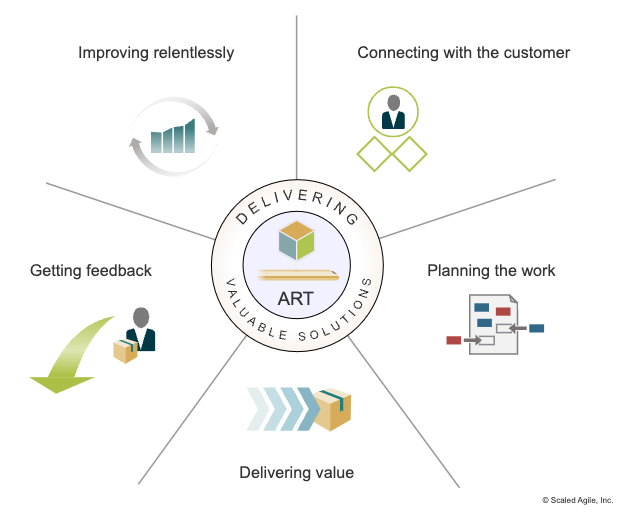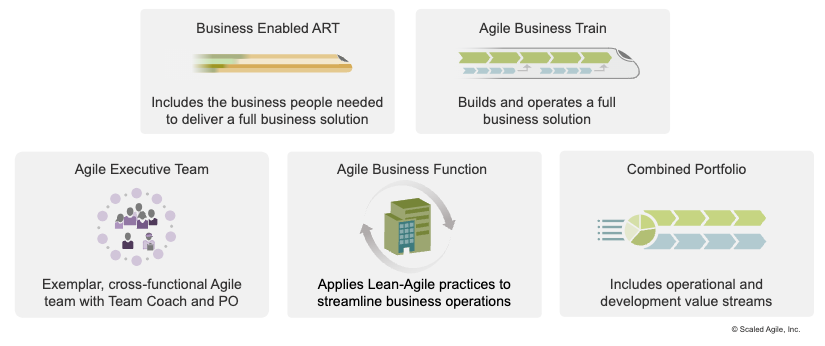Work Differently. Build the Future. – this is the message brought by the new version of the Scaled Agile Framework 6.0. And it gets to the heart of what is important these days: keeping pace with constant change, being and remaining fit for the future – that is one of the central challenges facing companies today. In order to master them, it is not enough for a few teams in an organization to apply Lean-Agile practices; the entire company, every single employee, has to pull together. And just as companies have to keep reinventing themselves, SAFe® has to continuously develop and adapt to changing market conditions.
But what exactly does that look like? What innovations does SAFe® 6.0 bring with it and what does the polished and adapted framework look like now? We’ll tell you!
SAFe® 6.0 – a comprehensive upgrade
First of all: It’s not about an extension, an incremental update or a version X point anything. SAFe® 6.0 is a complete, comprehensive upgrade with new applications and capabilities, a new Big Picture (BP) plus updated terminology and classifications. The known overview now looks like this:
The 6th edition of the SAFe® framework is based on exactly 6 pillars, which we will introduce to you in more detail below:
Pillar 1: A Stronger Foundation for Business Agility
If you’ve been in the industry for a long time, you’ve heard it – in different variations – often: “The speed of change in the digital age is breathtaking”. Do you remember Moore’s Law? It refers to an observation made by Gordon Moore in 1965 and states that the number of transistors in a dense integrated circuit (IC) doubles about every two years. Originally discussing physical components, over time this focus has expanded to include how fast technology is evolving or changing in general.
Looking at the events of the last three decades, it is easy to understand this amazing speed in terms of technological development: the PC boom in the 80’s, the rapid spread of the Internet in the 90’s, the introduction of mobile phones in the early 2000s and over the last decade the ever deeper integration of social media, cloud computing and artificial intelligence (AI) into our everyday lives.
In recent years, not only has technological change accelerated, but also the way in which (and how quickly!) these changes are integrated into our professional and private lives. We’ve gotten used to the newest and best coming out every six months, and then settle for that.
In the context of SAFe®, this means that Business Agility must be adopted at all levels of the organization, not just to succeed but to survive. And to better prepare Agile Practitioners for this digital transformation, key foundational elements of SAFe®, such as the Business Agility Value Streams (BAVS)also with a view to the changes in the near future, has been fundamentally updated and modernized.

In addition, extensive changes were made to the SAFe® Foundation made, which we will deal with in a separate article. Spoilers: Both the focus and the thinking regarding the Lean-Agile Mindsets – i.e. the core value and principles of SAFe® –, the Implementierungs-Roadmap or the fact that the “SAFe® Program Consultants (SPCs)” in “SAFe® Practice Consultants” have been renamed have changed somewhat and make it clear that the focus is on the speed of change. At the same time, the need is emphasized Business Agility in this context is.
Pillar 2: Empower teams and clarify responsibilities
Think of the “Definition of Done (DoD)” – all parties involved have defined and agreed upon the necessary criteria for when a project or deliverable can truly be considered completed. In the specific context of this article and SAFe® 6.0, the previous roles and responsibilities have been further refined and clarified. This has a positive effect: teams work together more efficiently and better, team members are strengthened and leadership also improves.
This topic alone could fill an article of its own – after all, it encompasses everything from Epic Owners and Release Train Engineers (RTEs) to the Agile Release Train (ART) itself. For the purposes of this article, let’s take a closer look at the ART and how the responsibilities were further clarified by a “Responsibility Wheel”:

Responsibilities of an ART
An ART develops solutions in an interactive process. There is a dialogue with the customer to ensure that the end result is mature and therefore optimized.
Pillar 3: Accelerating the flow of values
We stay with the pace and flow of change: In SAFe® 6.0, the eight general properties of value flow identified and Flow Accelerators defined, which further improve this process. Activities that accelerate the value stream include:
- That work in progress is visualized and limited,
- that bottlenecks are addressed,
- that handoffs and dependencies are minimized,
- that feedback can be accelerated,
- that tasks are broken down into smaller elements,
- that queues are shortened,
- that the focus time is optimized,
- that outdated policies and practices are abandoned.
In four new Flow articles (Team Flow, ART Flow, Solution Train Flow und Portfolio Flow) describes in detail how the eight flow accelerators can be applied. This is an additional extension of SAFe® Principle #6: Visualize and limit work in progress, reduce workloads and manage queues. Each of these flows offers suggested techniques to optimize and reduce problems to ensure the continuous stream of value at the respective SAFe® levels.
Pillar 4: Improving business agility with SAFe® across the enterprise
We believe that for a Lean-Agile transformation to deliver the best results, it must be a team effort and take place at every single level of an organization.

During a transformation, there is something like an ebb and flow: while in one part of the organization a certain element or step can be implemented smoothly, in another part of the company the same element will most likely reveal deficiencies in one or more areas. After extensive research on this topic, five fundamental elements have emerged that contribute to the concept of “enhancing business agility”: Business-Enabled ART, Agile Business Train, Agile Executive Team, Agile Functional Department and Combined Portfolio.
Pillar 5: Shaping the future with AI, big data and the cloud
Fact is: ChatGPT, Large Learning Models (LLMs), Bard AI, Jasper Chat and the like are now more and more part of our everyday conversations on our LinkedIn posts and Google Spaces. In this respect, one can justifiably claim: The future has long since arrived!
SAFe® recognized the digital signs of the times years ago and therefore developed a series of editorials on the three related topics of artificial intelligence, big data and cloud. They describe that concepts such as business agility and lean-agile mentality can only permeate your company if (and how) you implement these topics (AI, big data and/or cloud) in your organization.

© Scaled Agile, Inc.
Because this is truly a “moving target,” we expect more guidance and reflection on these topics from Scaled Agile in the near future.
Pillar 6: Get better results with Measure and Grow and OKRs
The three measuring ranges of SAFe® – Outcomes, Flow and Competency – Focus directly on measuring the progress of own business agility at all levels of SAFe®. These metrics provide deeper insights into areas for improvement and provide additional data and information for the decision-making process.

In addition, Objectives and Key Results (OKRs) have been included in SAFe® to achieve these three goals:
- Improve strategic alignment across a SAFe® portfolio
- Define business outcomes for epics and lean business cases
- Set improvement goals for the SAFe® transformation
As for the backlogs, a Kanban system has been put in place to better manage these issues from start to finish. There was also a standardization of ART, Solution and other terminologies with the aim of making the language use easier and clearer. Again, the details are too extensive to include in this article, so we’ll revisit this topic at a later date. (As you can see, we have no shortage of content ideas for our blog… 😉)
Curious? We are too!
And that was just the beginning! A tremendous amount of work has gone into the SAFe® 6.0 upgrade and we’ve given you just a little taste of what’s behind it. On the Scaled Agile Framework side you can find more information about what SAFe® 6.0 has in store.
The best way to SAFe® – we will find it together
We know implementing SAFe® can be intimidating. But with the right tools and, above all, the right partner, that doesn’t have to be the case! Whether the transformation is still in its infancy or is already being scaled to the next level: we evaluate each step together, advise on methods and the use of suitable tools and accompany you through the entire process. Our know-how around the introduction of Agile Hive, Yes and Jira Align we combine for an optimal result with the expert knowledge of KEGONGermany’s leading SAFe partner and SAFe® first mover in Europe.
Just contact us – we look forward to supporting you on your path of transformation!
Additional information
The rocky road to implementing SAFe® in Jira – and how to do it easily with Agile Hive
5 ways Agile Hive with Atlassian Jira supports the SAFe transition
Jira Align meets Agile Hive: similarities and differences, strengths and challenges, target groups and use cases
Warning: risk of poisoning! – Agile Transformations and “Low Hanging Fruits”
